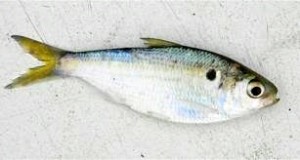Threadfin Shad (Dorsoma Petenense)
Common Names: Hickory Shad

Range: Threadfin shad are native to the U.S. west of the Appalachian Mountains. They have also been introduced in many Texas lakes and rivers as a forage fish for larger sportfish species. These fish are extremely sensitive to cold water, and do better in states with warmer temperatures.
Description: Threadfin Shad are relatively small forage fish with a body shaped like a lance. They have a flattened belly with a sawtooth belly. They are usually silver in color fading to black or blue near the caudal fin. Threadfin and gizzard shad both have a long thread like filament at the end of the dorsal fin. You can distinguish a threadfin shad from a gizzard shad by the yellowish tint to their dorsal and caudal fins. Threadfin shad reach maturation between two and five inches.
Biology and Life History: As mentioned above, threadfin shad are a warm water species that will die if water temperatures go below 6 degrees Celsius. They can be found in open brackish waters, as well as large ponds, lakes, and reservoirs. They are dependent on light for foraging and will stay high in the water column. Very tolerant of salinity, threadfin shad can even live in salt water environments. They can be found in organized schools based on size. Threadfin shad feed exclusively on plankton but have two methods of obtaining it, leading to a diversity of diet. They can spawn as early as their first summer of life but often wait till their second summer to mate. Mating occurs between August and July. The lay sticky egg masses that clump to the substrate or floating objects. Few of these fish live to be older than 2 years or grow over 10cm long.
Stocking: Large murky bodies of water are ideal for stocking threadfin shad due to threats from predation in small clear water bodies. Sufficient numbers must be stocked in order to have a healthy reproductive population. New or recently renovated lakes are ideal for stocking threadfin shad, and must be at least 10 acres. Annual spring stockings may be needed to support the population. In a new lake 100 per surface acre is an adequate stocking ratio. In lakes smaller than 100 acres 200 per acre may be stocked. And in lakes larger than 100 acres, 100 per acre should be stocked. Ideally threadfin shad should be stocked prior to spawning season in the summer months.
Adapted From:
http://calfish.ucdavis.edu/species/?uid=100&ds=241
http://wildlife.tamu.edu/files/2010/04/2_Threadfin_Shad_MGMT.pdf
